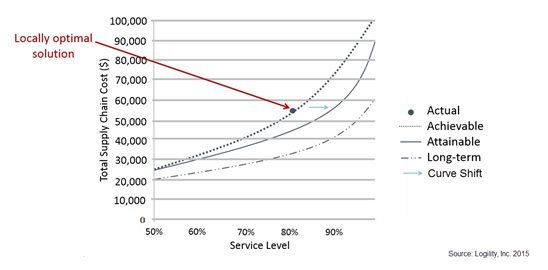
That was the uplifting message from a keynote session delivered by Dr. Sean Willems at Logility’s Connections 2015 customer event. Over 300 people, including SC Digest Editor-in-Chief Dan Gilmore, listened as Willems re-drew the classic graph of trade-off assumptions for pairs of co-dependent supply chain variables such as service level vs. total supply chain cost, stock-out rates vs. inventory levels, on-time deliveries vs. transportation costs. SC Digest covered the presentation recently here: Understanding the Supply Chain Efficient Frontier.
“Academics love to reduce the world to two dimensions,” Willems observed, prompting laughter from the audience as he presented a plot of Total Supply Chain Cost vs. achievable Service Level. This classic trade-off curve represents the Efficient Frontier, the borderline between what is attainable (lowest cost for a given service level) and what is unattainable, given current resources. Willems pointed out that, rather than moving your organization from one point to another along this “attainable” performance curve, the goal of supply chain optimization is to create a whole new curve for the business to operate along.

Executing this “curve shift” is the very reason we model the end-to-end supply chain, perform “What If” analyses, and implement a strong S&OP process.
In Dan Gilmore’s column on Sean Willem’s keynote address, he says Supply Chain Digest has become “re-energized” on the topic of Efficient Frontier curve-shifting, which provides the basis for a compelling business case for supply chain transformation. As Dr. Michael Watson of Northwestern University told Dan, “You can shift the curves with innovative technology or processes.”
As Connections 2015 attendees know, the technology for this transformation is now right at our fingertips.




